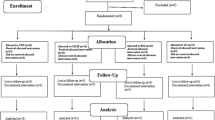Abstract
The purpose of this investigation was to examine the effects of in-season plyometric training program on power and agility performance in young male basketball players. Twenty intermediate basketball players (age 20.1 ± 1.3 years; height 181.1 ± 8.5 cm; body mass 78.8 ± 5 kg) from Division I province team volunteered to participate in this study and were randomly divided into two groups: plyometric training (PL; n = 10) and control group (CG; n = 10). Plyometric training took place twice weekly for 6 weeks including three sets of 15 repetitions of depth jump (from 45-cm box height), vertical jump, and standing long jump, in addition to regular basketball practice of the team. Vertical jump (VJ), standing long jump (SLJ), 4 × 9-m shuttle run, agility t test (ATT), and Illinois Agility Test (IAT) were measured at pre- and post-training. The PL group showed significant improvement (P < 0.05) in VJ (10.21 ± 2.72 cm), SLJ (21.15 ± 8.10 cm), 4 × 9-m shuttle run (0.62 ± 0.28 s), ATT (1.16 ± 0.57 s), and IAT (1.17 ± 0.65 s) after a 6-week training period and compared to CG. It can be concluded that a 6-week in-season plyometric training program has positive effects for improving power and agility performance in young male basketball players and this study provides support for coaches and basketball players who use this training method during competitive phase.

Similar content being viewed by others
References
Klinzing JE (1991) Training for improved jumping ability of basketball players. Nat Strength Cond Ass J 13:27–32
Arazi H, Coetzee B, Asadi A (2012) Comparative effect of land and aquatic based plyometric training on the jumping ability and agility of young basketball players. S Afr J Res Sport Phys Edu Rec 34:1–14
Brown ME, Mayhew JL, Boleach LW (1986) Effect of plyometric training on vertical jump performance in high school basketball players. J Sports Med Phys Fit 26:1–4
Matavulj D, Kukolj M, Ugarkovic D, Tihanyi J, Jaric S (2001) Effects of plyometric training on jumping performance in junior basketball players. J Sports Med Phys Fit 41:159–164
Chu DA (1998) Jumping into plyometric. Human Kinetics, Champaign
Miller MG, Herniman TJ, Ricard MD et al (2006) The effects of a 6-week plyometric training program on agility. J Sport Sci Med 5:459–465
Spurrs RW, Murphy AJ, Watsford ML (2003) The effect of plyometric training on distance running performance. Eur J Appl Physiol 89:1–7
Arazi H, Asadi A (2011) The effect of aquatic and land plyometric training on strength, sprint, and balance in young basketball players. J Hum Sport Exerc 6:101–111
Khlifa R, Aouadi R, Hermassi S, Chelly MS, Jlid MC, Hbacha H, Castagna C (2010) Effects of a plyometric training program with and without added load on jumping ability in basketball players. J Strength Cond Res 24:2955–2961
King JA, Cipriani DJ (2010) Comparing preseason frontal and sagittal plane plyometric programs on vertical jump height in high-school basketball players. J Strength Cond Res 24:2109–2114
Santos EJ, Janeira MA (2011) The effects of plyometric training followed by detraining and reduced training periods on explosive strength in adolescent male basketball players. J Strength Cond Res 25:441–452
Adams K, O’Shea J, O’Shea K, Climstein M (1992) The effects of six weeks of squat, plyometric and squat-plyometric training on power development. J Appl Sports Sci Res 6:36–41
Holcomb WR, Lander JE, Rutland RM, Wilson GD (1996) A biomechanical analysis of the vertical jump and three modified plyometric depth jumps. J Strength Cond Res 10:83–88
Saez–Saez De Villarreal E, Gonzalez-Badillo JJ, Izquierdo M (2008) Low and moderate plyometric training frequency produce greater jumping and sprinting gains compared with high frequency. J Strength Cond Res 22:715–725
Stemm JD, Jacobson BH (2007) Comparison of land and aquatic based plyometric training on vertical jump. J Strength Cond Res 21:568–571
Markovic G, Jukic I, Milanovic D, Metikos D (2007) Effects of sprint and plyometric training on muscle function and athletic performance. J Strength Cond Res 21:543–549
Saez–Saez de Villarreal E, Kellis E, Kraemer WJ, Izquierdo M (2009) Determining variables of plyometric training for improving vertical jump height performance: a meta analysis. J Strength Cond Res 23:495–506
Sale DG (1988) Neural adaptation to resistance training. Med Sci Sports Exerc 20:135–145
Hakkinen K, Alen M, Komi PV (1985) Changes in isometric force and relaxation-time, electromyographic and muscle fibre characteristics of human skeletal muscle during strength training and detraining. Acta Physiol Scand 125:573–585
Maffiuletti NA, Dugnani S, Folz M, Dipierno E (2002) Effects of combined electro stimulation and plyometric training on vertical jump height. Med Sci Sports Exerc 34:1638–1644
Potteiger JA, Lockwood RH, Haub MD, Dorezal BA, Almuzaini KS, Schroeder JM, Zebas CJ (1999) Muscle power and fiber characteristics following 8 weeks of plyometric training. J Strength Cond Res 13:275–279
Parsons LS, Jones MT (1998) Development of speed, agility and quickness for tennis athletes. Strength Cond J 20:14–19
Renfro G (1999) Summer plyometric training for football and its effect on speed and agility. Strength Cond J 21:42–44
Robinson BM, Owens B (2004) Five-week program to increase agility, speed, and power in the preparation phase of a yearly training plan. Strength Cond J 26:30–35
Sheffard JM, Young W (2006) Agility literature review: classification, training and testing. J Sports Sci 24:919–932
Acknowledgments
The authors would like to thank all the participants for their cooperation in this study.
Conflict of interest
None.
Author information
Authors and Affiliations
Corresponding author
Rights and permissions
About this article
Cite this article
Asadi, A. Effects of in-season short-term plyometric training on jumping and agility performance of basketball players. Sport Sci Health 9, 133–137 (2013). https://doi.org/10.1007/s11332-013-0159-4
Received:
Accepted:
Published:
Issue Date:
DOI: https://doi.org/10.1007/s11332-013-0159-4




